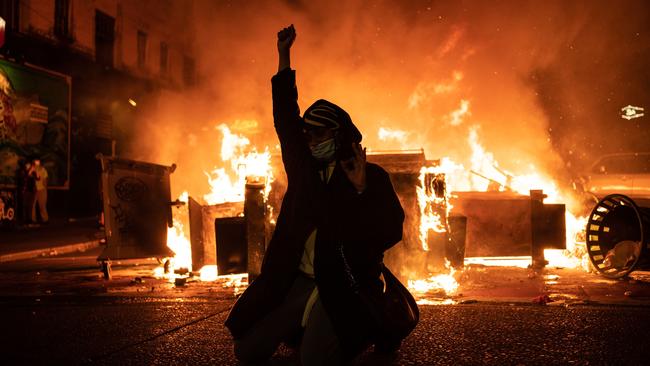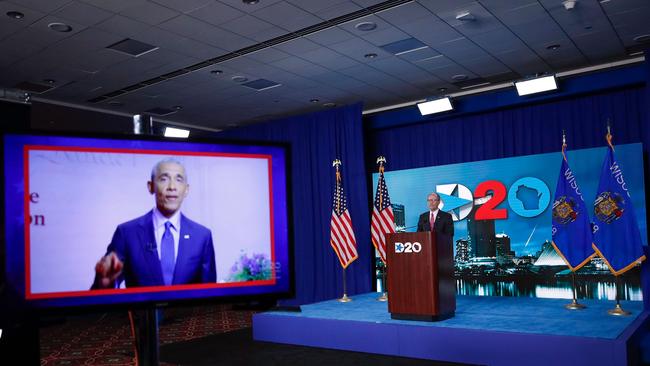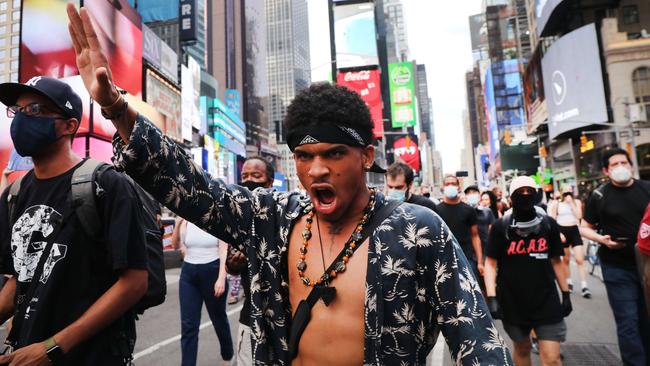Black Lives Matter on the march to destruction

I quickly ran to my apartment building, hearing the drone from a police car’s bullhorn blasting: “Clear the streets, go home, DC has enacted a curfew.”
This uproar was caused by the assassination of Martin Luther King Jr on April 4, 1968. The following two months consisted of demonstrations, riots and upheavals in more than 100 American cities because of racial inequality. Especially because of the lack of jobs available to black men, voter rights restrictions, inequality throughout the education system and other human rights issues. Blacks were fighting for justice and equality and lawful rights.
King believed in peaceful demonstrations. Then, just like now, some were peaceful. Others turned violent, causing most of the destruction and pillage in poorer black neighbourhoods. Just as cities were calming down, Robert Kennedy was murdered in Los Angeles in June. New sparks of violence began.

Behind these demonstrations, there were extraordinary civil rights leaders such as King. Robert Kennedy, Thurgood Marshall, Julian Bond, Jesse Jackson, Dorothy Height, Edward Kennedy, Rosa Parks, John Lewis and yes, to some extent, even Malcolm X. Supporting their efforts was the far-reaching organisational push provided by the National Association for the Advancement of Coloured People, National Council of Negro Women, the Urban League and many others. All working together to create measurable advancement and achievements for African-Americans.
We were making progress. The pressure was on as opportunities such as school choice, job access and management positions were becoming within reach to people of colour. From small neighbourhoods to the White House, we found solutions to resolve some differences. America was on the move. Not easy and often testy. Often through invisible lenses of dual emotions and discomfort. Yet it was a start. Many of us stayed the course.
As the new millennium approached, the cultural wheels of progress slowed and opportunity lost its momentum. Drugs were widespread and no longer restricted to poorer neighbourhoods. New technologies were replacing low-skilled labourers.
While many fathers were determined to survive and provide, many African-American men turned to alcohol, drugs and crime. Not an excuse, just the reality, and black men were sent to prison in huge numbers. This led to the further decline of the black family unit as husbands and fathers abandoned their families and communities, ghettos and slums sprang up across urban America.
The scales of injustice were and still are abysmal. Only recently has prison reform become topical and out in the open. The Trump administration has begun small steps with the Criminal Justice Reform Act, creating punishments to fit the crimes and reduce sentences.
For the past few decades numerous cities have been managed by Democrat mayors — many African-American — with diverse city councils. In the same period, we have watched some deteriorate into ghettos. Homelessness, crime and shootings are increasing rapidly in New York, Detroit, Baltimore, Chicago, Los Angeles and San Francisco. After this northern summer, we can certainly add Seattle, Washington and Portland, Oregon to this list.
America is crying out for national leadership — especially for the under-served. Where are our national leaders? Barack Obama has not taken up the baton. The old guard is gone.
Different times
Comparing the demonstrations of 1968 and Black Lives Matters demonstrations in 2020, there are very few similarities.

In 1968 demonstrations were mostly on behalf of positive change with clear goals — goals of upward mobility and the American dream. BLM demonstrations began when a policeman murdered a black man, Eric Garner, whose dying words — “I can’t breathe” — became the BLM rallying cry.
Initially, BLM claimed its purpose was to stop police brutality of black boys and men. Yet right from its inception most demonstrations have had an element of crime and destruction. Part of the movement’s mantra is “Hands up, don’t shoot”, “No justice, no peace”, “Only good cop is a dead cop”, “White silence is violence.” Further, some supporters of BLM and Antifa and others who join them are angry thugs who attack innocent people, loot, burn and destroy private and public property.
Will the BLM movement ever clarify its true agenda? Since the death of George Floyd on May 25, BLM has hardly mentioned police brutality or any social justice concerns of African-American lives. What we have seen are demonstrations pushing a movement of extreme socialism, with vestiges of fascist and Marxist overtones.
BLM struck a positive note. Following the death of Floyd, the outpouring of national and global support on behalf of justice for black males at the hands of police brutality marked a worthy moment in history recognising a turning point — enough is enough.
Having marched often in 1968 and once with BLM, I believe my vision is pretty clear. I joined a BLM march and demonstration in Maryland in 2015. Before long, I realised five or six men standing near me were getting fired up, and were about to knock down a statue and vandalise the state capital building. Fortunately I convinced them that a positive story in the morning news would be a better headline than one of vandalism. The statue of Roger Taney was most deservingly and peacefully removed shortly thereafter.
For several years during the late 1970s and early 80s, I demonstrated with Stevie Wonder, Jesse Jackson, Reverend Al Sharpton and others to achieve the victory of a King national holiday. I got frostbitten fingers and toes from these wintry January demonstrations. While driving to work one morning in 1983, it came over the radio that Martin Luther King Jr Day was proclaimed a national holiday. I wept the rest of the way to work.
From May 25 to June 31, BLM demonstrations accounted for 1000 people injured, 70 killed and $US8bn in damages — claimed to be the most destruction to cities since the Los Angeles riots in 1992. Nine people were shot by law enforcement officers and one by a National Guardsman. It is difficult to acquire real-time death figures and destruction costs. It is not politically convenient — especially in this identity politics election year. Several thousand individuals have been injured, and injuries to police are no longer expedient in this cancel culture environment.
BLM remains unclear about its true purpose and it is reluctant to negotiate peaceful terms. Does it make good sense for the movement to destroy the statues of Frederick Douglass, George Washington, Thomas Jefferson and Abraham Lincoln, deface plaques commemorating Parks and countless others who fought for civil rights and justice for all?
There is an even bigger problem. It is black-on-black killings and other crime within black communities. Chicago’s black communities alone suffer 20 to 40 plus deaths from shootings on a weekly basis. And the deaths outnumber by far deaths from police brutality.
President Donald Trump sent in the National Guard to end the riots in Washington, DC and Seattle. Their mayors — both women — kicked out his national assistance. Seattle’s mayor Jenny Durkan said she could handle the demonstrations and commented this was like “a summer love fest”.

As we watched the Democratic and Republican national conventions, it became obvious that Joe Biden and his team had misread the mood by not mentioning the violence BLM has caused. The Republicans highlighted law and order and a commitment to end the nightly violence in Democrat-managed cities and positively identified benefits Trump has provided to people of colour since 2016. In addition, Trump continually promised Americans that police would not be defunded and reminded them that he is — and has been — ready to send the National Guard to cities as soon as mayors and governors will allow. Trump’s visit to Kenosha, Wisconsin this week was welcomed by numerous white and black residents as it helped calm the violence with residents stressing the need to reopen their businesses and schools.
And Democrats? All of the usual suspects are deafeningly silent. Biden, Nancy Pelosi, Chuck Schumer, even Alexandria Ocasio-Cortez — all quiet as a mouse. Biden infrequently pops up to offer very brief, incomprehensible sound bites — but not about America under siege by BLM. New York City mayor Bill de Blasio busies himself painting streets in support of BLM. Yet he continues to ignore the nightly violence in his city. And he refuses to accept Trump’s help.
Could the political silence have something to do with this being an election year? Democrats and Republicans are playing Russian roulette with this election. Democrats failed all previous attempts to force Trump out. Russian collusion and impeachment didn’t work. Is BLM the wildcard, the pawn of both Democrat and Republican parties? Democrats are standing down, hoping voters will blame Trump for the nation held under siege. Republicans are betting Democrats will take the fall.
We shall all know who dodged the bullet come Election Day on November 3. But what will they have won?
Barbara T. Heineback was a press officer to US first lady Rosalynn Carter.



Returning home from university, I got off the bus a few blocks from my apartment in Mount Pleasant, in Washington, DC. Suddenly, as I crossed 16th Street, I was sprayed with tear gas. My eyes burning, I stumbled on to the sidewalk. Shops were being boarded up and closed. People rushed out of the big Safeway supermarket yelling, “Go home, get off the streets.”